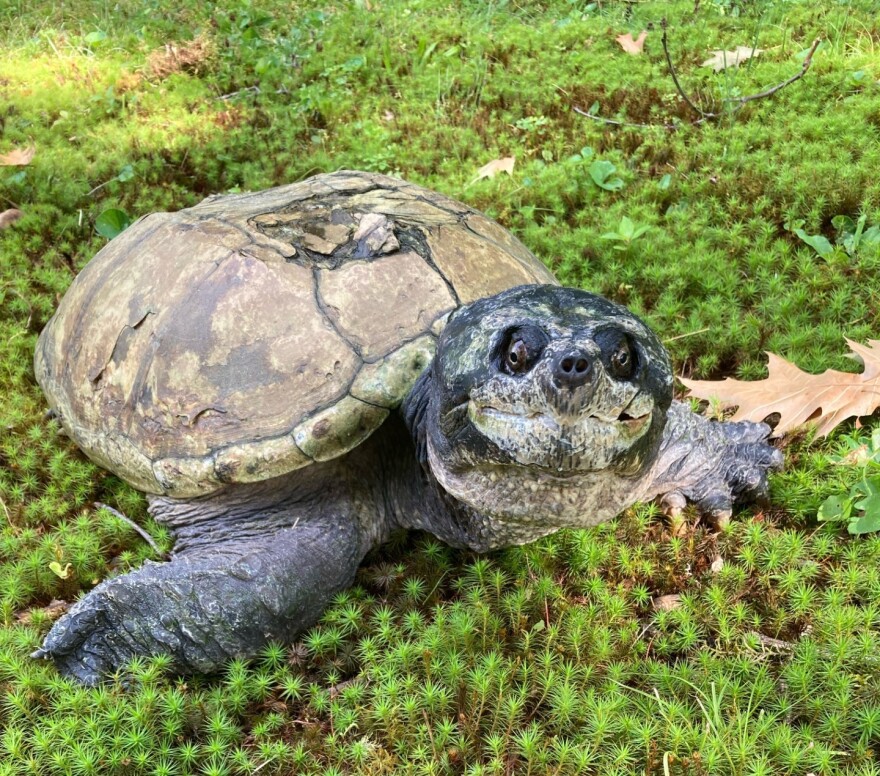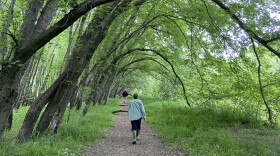Turtles are on the move in New Hampshire this time of year, in search of nesting grounds. It's a high risk time for pregnant females if they have to cross roads to find a good spot.
With New Hampshire Audubon’s Chris Martin out in the field, co-host Dave Anderson talks with Drew Stevens and Dallas Huggins, founders and licensed wildlife rehabilitators with New Hampshire Turtle Rescue, based in Nottingham.
“We rescue and rehabilitate all seven native species of turtles that we have here in the state, and we release them right back where they came from,” says Drew Stevens, one of the founders of New Hampshire Turtle Rescue and a licensed wildlife rehabilitator.
The most common and widespread turtles native to New Hampshire are painted turtles, snapping turtles and musk turtles. The Blanding's turtle, spotted turtle, wood turtle, and box turtle are identified as species in greatest need of conservation in the New Hampshire Wildlife Action Plan, according to New Hampshire Fish & Game.
“Unlike rehabilitating and releasing a bird who can fly and figure out where it wants to go, that [injured] turtle really needs to get right back to its home population,” Stevens says.

Stevens reiterates how much of their effort is spent in researching the location where that turtle was found.
”We consult with the New Hampshire Fish and Game biologists," he says, "who are experts in these turtles and know where their populations are.”
“It's just so impactful when you can get them back. Especially every time we can get an endangered species back, it feels so good,” says Dallas Huggins, licensed wildlife rehabilitator and co-founder of New Hampshire Turtle Rescue.

Turtles are on the move much of the year. When it gets warm, they may move from overwintering wetlands to vernal pools and other wetlands to start eating and fattening up. After finding their nesting grounds, they’ll move into other wetlands until it starts getting cold, when they'll head to their brumation spot: the turtle’s version of hibernation.
But the busiest time of year for the rescuers and rehabilitators is when the pregnant females are migrating during turtle nesting season. It’s also the most crucial time for the survival of wild turtle populations.
“When you've got a female turtle who's got to go lay eggs, if she has to cross a road to do that, that's two times that she's putting herself at risk. Once to cross the road, to go lay the eggs, and then wants to come back to the wetlands that she came from. So year after year, it's a risk that these turtles run,” says Stevens.
Stevens and Huggins make a connection with each turtle they rescue. “And we get to see their personalities up close,” says Huggins. “People don't see the individual personalities that you often see in rehab.”

Contrary to their name and reputation, Huggins says snapping turtles are patient and gentle. “They get such a bad rap. But they're so patient with us here. We always think it's funny because everybody's scared of them. But we've been bitten a million times more by painted turtles than snapping turtles,“ she says. “They’re feisty little guys.”
“Last year we got a call about a Blanding’s turtle that was in a pretty bad way,” says Stevens. “It had very severe carapace injuries, the carapace being the top of the shell. It was shattered pretty much all over the front of it where the pieces were hanging. We weren't sure that that turtle was even going to survive the night, and we weren't sure exactly how well that shell would be able to be repaired.”
He describes the turtle as being on the precipice of death and notes the high stakes for a pregnant Blanding’s turtle. “There are studies that have shown that losing an adult Blanding’s turtle, even one every five years from a population, is enough to eventually extirpate that population of Blanding’s turtles.”
This turtle was lucky. “We spent hours getting that turtle back together, and we managed to somehow put that shell together, almost like it had never been broken before. That turtle's name was Myrna and she made such an amazing recovery.”
The resilience of the injured turtles continues to impress the rehabilitators.
“Being able to be a part of relieving her pain and then being able to go out and release her back to her home and see her go back into her swamp to hopefully live a long life… it just really was touching. She really surprised us. And turtles in general, they just really surprise us with what they can withstand and what they can go through,” says Stevens.

New Hampshire Turtle Rescue depends on a volunteer network to help transport injured turtles to the facility in Nottingham.
“They have been indispensable in helping us get some of these turtles as soon as possible so they can start getting treatment,” says Stevens.
But Stevens describes the work they do as a “band-aid” solution to helping turtle populations.
“We are reactive to a problem that already exists,” he says. “Once a development goes in, once a road goes through and bisects a wetlands or even next to a wetlands, those turtles are now at risk. And for those populations, there's nothing that can be done to really save them. The only thing that can be done long term to preserve and guarantee a future for our wild turtles is to support land conservation efforts to save these pristine habitats from becoming developed.”
NH Turtle Rescue has photos and stories about rescued New Hampshire turtles on their website.
If you want to help turtles, they suggest:
- Watch for turtles crossing the road. Helping them get across the street in the direction they are headed can save their life. NHTR has instructions on how to do this safely.
- Get injured turtles to a licensed wildlife rehabilitator. You can save their life by taking the time to get them to a wildlife rehabilitator.
- Keep wild turtles in the wild.
- Never release pet turtles.
- Check on your pets when they are outdoors. NHTR is increasingly seeing turtles gnawed by dogs and other predators.
- Let turtles nest in your yard undisturbed; it's likely a nesting female. Keep pets away and give her space to lay her eggs.
- Know before you mow. Help wildlife by doing a survey of your lawn before mowing, to identify if any critters, such as box turtles, are using your grass for cover.
The New Hampshire Turtle Rescue website also has resources for learning more about New Hampshire turtles and how you can help turtles in the state. There is also information on the New Hampshire Fish & Game website.
Something Wild is a partnership of NH Audubon, the Forest Society, and NHPR.












